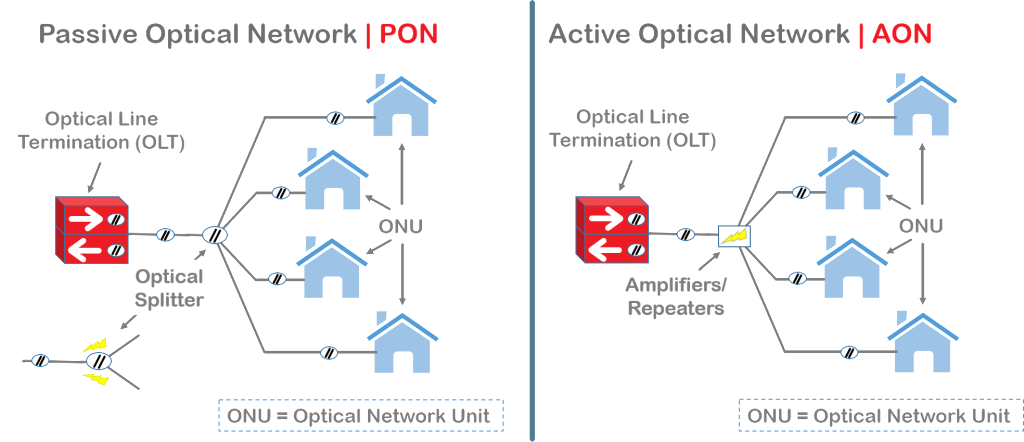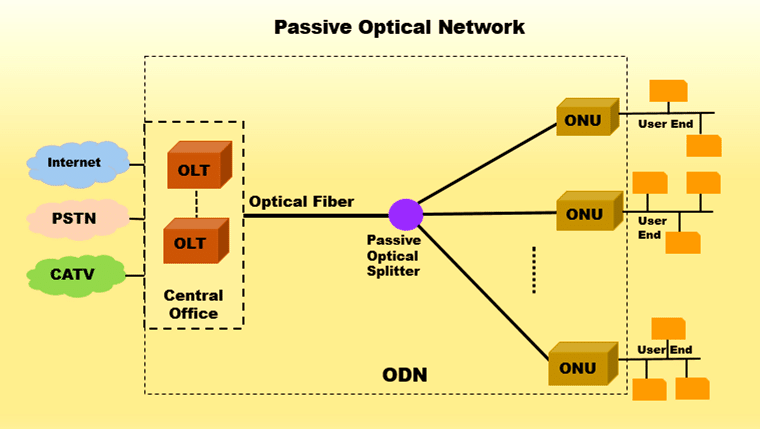The fact that fiber optics are used in the transmission of light-signal data is widely known, as is the fact that separated ways are required to allow those signals to arrive at their intended destination. Typically speaking, there are two types of network that are employed to achieve this goal:

- Active Optical Networks (AONs)
- Passive Optical Networks (PONs)
However, in this article, we focus on the latter and why it’s vital to perform testing on these passive networks before they’re officially deployed.
Passive Optical Networks Defined
In the modern day, huge investment is being put into access networks by service providers to meet the ever-growing high-bandwidth broadband demand. These same server providers prefer to see an evolution of technology, as well as longevity, to meet future demand, which is why the use of PONs is being seen more and more frequently.
PON is a technology used in telecoms to implement a point to multipoint architecture, and it can serve numerous endpoints from a single optical fiber, through the use of unpowered splitters. The net result of this system (which could be referred to as FTTH (fiber to the home), FTTB (fiber to the building) or FTTC (fiber to the curb)) is that each customer no longer needs to be connected to the hub by separate fibers. (academia 2010)
PON Components

A typical PON is comprised of multiple ONUs (optical network units) and an OLTs (optical line terminations). Generally, an OLT is located at the central office of the server provider, with as many as 32 ONUs situated close to the end users. The ‘passive’ part of the nomenclature refers to the fact that while the optical signal is traversing the network, there are no active electronic parts, and no power is needed.
In FTTH, a PON system allows for costly hardware components to be shared, as a splitter can take a single input and separate the signal to transmit to multiple users. This sharing can result in cost savings to the service provider, especially as splitters can send signals in both directions, from the central office to the users and vice versa.
Optical Splitters
A PON uses non-powered optical splitters to separate signals as they progress through the network, sharing strands of fiber optics for different parts of network architecture. Because PONs only require power at the transmitting and receiving ends of the network and can serve up to 32 users with a single strand of fiber, they offer an option that’s both cheaper to build and to maintain than an AON. (Research Gate Mar 2018)
That’s not to say that PONs are perfect, as they have a few disadvantages - namely that they have a shorter range than an AON and when an outage occurs, it’s trickier to isolate the issue. Also, as bandwidth is shared between subscribers in a PON, the speed of data transmission can drop at peak times of the day, which can cause issues to smooth service use.
The Benefits of a PON
PONs came into mainstream use back in 2009, as they were designed as a way of connecting homes to internet, telephone and TV services en masse. The reason they became so popular is that they come with several benefits:
● Reduced operational costs
● Lower installation costs
● Reduced network energy costs
● A reduction in required network infrastructure
● No requirement for network switches
● IDF real estate can be reclaimed
When a PON is deployed, it will typically replace large bundles of legacy copper wiring with a much smaller and more manageable and cheaper to maintain single mode fiber cable. This allows for greater distances between desktop and data center (up to 20km), and it represents a much more secure option than copper, as it's more difficult to tap and encryption occurs between the ONT and OLT.
Importance of Testing Before Deployment
Before a PON is deployed, it’s vital that its installation is properly tested as, to meet the client’s expectations, the reflectance levels inside the fiber need to be within acceptable parameters. If proper testing isn’t conducted and an excess of reflectance and signal loss within the network is allowed to persist, it can lead to serious performance issues.
A practical method of testing a PON often involves using OTDR (Optical Time Domain Reflectometry) equipment, which passes the wavelength frequency to be used through the network so that any issues are immediately highlighted. (Building Industry Consulting Service International (BICSI) 2018)
In Conclusion
While PONs have existed in the telecoms industry for many years, they are, at last, being used at an enterprise level in healthcare, education and a host of other sectors, offering new opportunities for new, low-cost, low-maintenance infrastructures. Of course, there will be instances where AONs may be more appropriate, but fully-tested PONs and what they offer is finally (and rightly) being seen as a viable alternative to their more expensive, powered counterparts.
If you would like to find about more about anything discussed here, you should head over to our website www.m2optics.com. If you would like to talk to one of our friendly experts about how our products can assist in your next project, call us at 919-342-5619, and we’ll do everything we can to help.
Since 2001, M2 Optics has been an established manufacturer and innovator of professional optical fiber platforms for fiber network simulation, latency / optical time delay, training, and demonstration applications. Our customer base includes many of the world's most recognized communications service providers, equipment manufacturers, data centers, web service providers, financial institutions, research institutions, and government agencies.
References
Larsen, Gavler, & Wang. (n.d.). Comparison of active and passive optical access networks. Retrieved from https://www.academia.edu/16259129/Comparison_of_active_and_passive_optical_access_networks
Optical splitter design for telecommunication access networks with triple-play services. Retrieved from https://www.researchgate.net/publication/324231791_Optical_splitter_design_for_telecommunication_access_networks_with_triple-play_services
Field Testing and Troubleshooting of PON LAN Networks per IEC. Retrieved from






